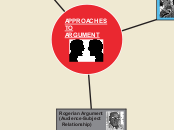APPROACHES
TO
ARGUMENT


Toulmin Model
(Writer-Audience-
Subject Relationship)
<---- Stephen Toulmin
Claim
Claims of Fact
- claim that uses undeniable facts that
that the audience cannot argue against
Claims of value
- "attempt to prove that some things are more or less desirable than others." (Rottenberg 25)
Claims of policy
- "assert that specific policies should be instituted as solutions to problems." (Rottenberg 25)
Support
The way the writer convinces the audience that his claim is correct.
- Writer uses evidence like statistics and testimonies
- Writer uses motivational and emotional appeals
Warrant
Rogerian Argument
(Audience-Subject
Relationship)
Carl Rogers----->

Common Ground
Involves emotionally involved writer and audience that have different opinions on an important topic.
How to achieve a Common Ground
1. State topic of argument
2. Acknowledge both sides of the
argument
3. Explain your side of the issue
without creating controversy
4. Share common interests and
differences
5. Suggest compromise/common
ground
"The test of the writer's ethos, or ethics, is how fairly she sums up her opponent's views." (Rottenberg 20)
Aristotelian Rhetoric
(Writer-Audience
Relationship)
Aristotle----->

Pathos
Writer's appeal to the audiences emotions.
- Most effective emotional appeals are pity
and fear.
- "An argument hits home when it hits close
to home." (Rottenberg 8)
Logos
The logic (evidence, proof) of an argument
- Enthymeme: takes major premise (broad fact) and minor premise (more precise fact on same topic) to come to a conclusion.
Ethos
Credibility of the arguer which helps to persuade the audience
- Aristotle thought ethos to be "the most important element." (Rottenberg 7)
- Audience trusts the arguer when the arguer is intelligent, trustworthy, credible.
